Pump for pumping out sewage: features, choice
If you have a private house and an individual sewage system, you can either call periodically special services to maintain a septic tank or AU, or service the devices yourself. Service prices are such that, despite a very unpleasant procedure, people do it themselves. For such work, you need a fecal pump for sewage. This is a special device that can pump very dirty water.
The content of the article
Drainage and fecal matter - what is the difference
There are two types of pumps for pumping contaminated water: drainage and fecal. How are they different? Drainage systems are designed to drain polluted waters containing small solid inclusions - silt, sand and other substances of approximately this size. To prevent larger particles from getting inside, nets are installed. As you can understand from the description, drainage pumps are suitable for pumping clarified water from a storage well located after a septic tank, for pumping water from a storage well for drainage and storm sewers.
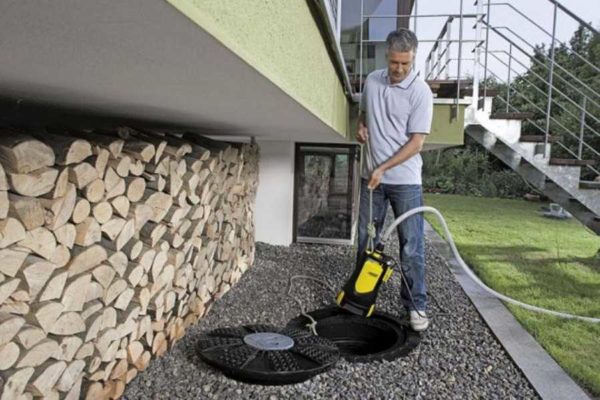
A fecal pump for sewage differs from a drainage pump in that it can pump viscous media with rather large solid particles
If you need to pump out sludge from an automatic individual purification plant (type Topas or others), or sediment from the bottom of the septic tank, the drainer will not cope with this. The environment is too dense. For a septic tank, there is, in principle, a way out, stir up the sediment, pump out the suspension, pour water again, shake it up and pump it out again. You can do this, but the septic tank will then go into operation for a very long time, so this method can be used only in extreme cases. It is better to purchase special equipment that will cope with the compressed sediment.
To clean cesspools and septic tanks, fecal sewage pumps are used. They can handle highly contaminated liquids, viscous media that may contain solid particles. The particle size depends on the model, but the maximum size is 50 mm. Not always in a cesspool all waste is rotted to such a state. To cope with the situation, a chopper is installed at the bottom of the pump. It is usually placed on centrifugal models - additional cutting blades are installed on the shaft. The drains are already crushed into the working body of the pump.
So if you plan to use a fecal pump to pump out a sump, it is desirable that a chopper be present in the model. It grinds larger particles to an acceptable size.
Types of fecal pumps
Sewage pumps operate in an aggressive, chemically active environment. In addition to the fact that their housing must be sealed, the materials from which it is made must be chemically neutral and resistant to aggressive environments. There are very few such materials:
- stainless steel;
- some types of plastic;
- cast iron.
The best material is stainless steel, but the same material is the most expensive. The most budgetary option is a plastic case. These models are the cheapest. In the middle price category, fecal pumps for pumping out sewage with a cast iron body. Despite the fact that you rarely use this device, you should not choose cheap models. Is that for a summer residence, where you come only from time to time.
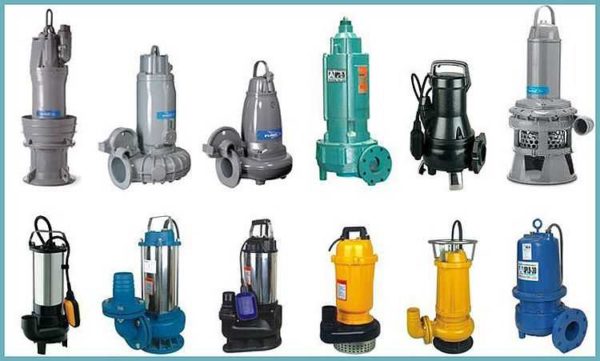
This is all submersible sewage pumping fecal pump with grinder
By the type of installation, pumps for pumping out feces are:
- Submersible. They are installed on the bottom of the tank and usually work in automatic mode. Switching on / off takes place using a float switch.The float rises / falls with the liquid level, when it is at the bottom, the pump is turned off.
- Semi-submersible. These pumps are elongated in length, their suction part is quite far from the motor. The motor remains on the surface, it floats on a special platform, the suction part is thicker.
- Superficial. Only the hose connected to the inlet is lowered into the tank, the device itself is located next to the tank. A surface sewage sewage pump usually has a plastic body and a small capacity. This is basically a summer cottage option.
Now we need to figure out in all this diversity - when and what devices are better to use.
Features of operation and installation
When choosing a fecal pump for sewage, you must first of all be based on the operating conditions of the equipment. If you are looking for equipment for a summer residence, there is no need to spend money on expensive and powerful submersible models. For these purposes, small and mobile surface installations are optimal. They are good because you can take them with you for the winter - they weigh 5-12 kg, depending on the power. If equipment is being selected for a private house of permanent residence, it makes sense to purchase more expensive equipment that can be permanently mounted.
Submersible fecal pump
This equipment can be installed permanently or mobile. In a stationary installation, a platform is made at the bottom to which the body is attached. Pipes (usually plastic) are connected to the outlet. The option is not bad, but if there is a need for repair or maintenance, it is not clear how to get the unit.
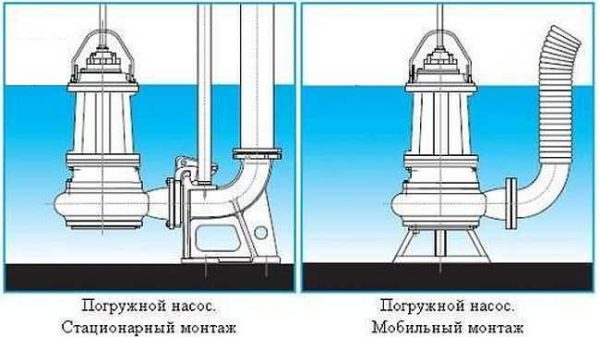
Installation options for a submersible sewage pump
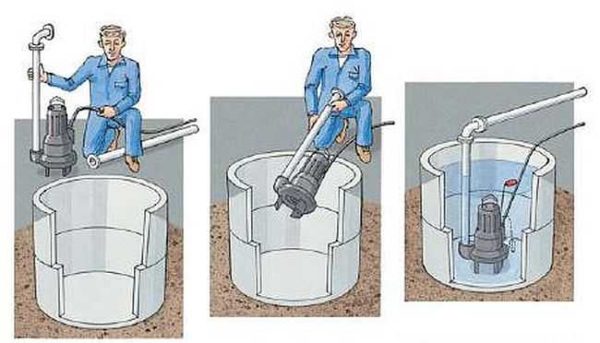
How to install a submersible fecal pump for sewage yourself
The pipe from the pump can be brought up to the surface of the earth, or it can be led out into the wall and laid, say, to the storage tank, a pipeline underground. This is an option for those who cannot reach a septic tank / cesspool with a conventional sewer truck. In this case, a call to a special machine with a long hose is necessary. But a couple of these calls are equal to the cost of a mid-range mud pump. Therefore, often in such cases, a storage tank is built / installed in accessible places, the residues are pumped into it with the help of a fecal pump, and then a regular machine is called.
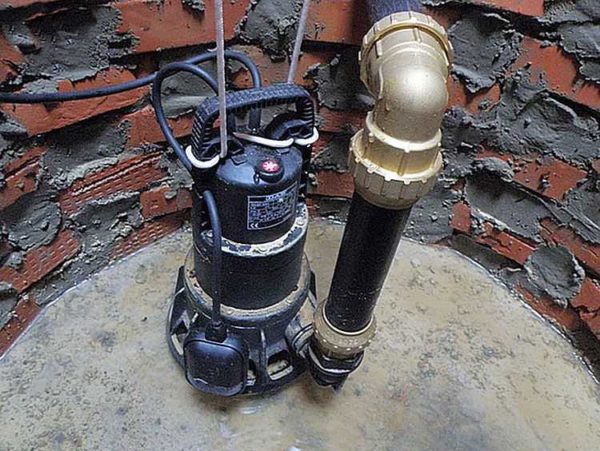
How it might look in finished form
The second, mobile option is better in this regard. Two rods are mounted along one of the walls of the tank. The diameter is slightly less than the diameter of the holes in the body. A chain is attached to the upper part of the submersible sewage pump, a corrugated pipe is connected to the outlet pipe. Then the body is put on the installed rods, and, like on rails, the device is lowered to the bottom. With this installation method, if necessary, the pump is pulled out by the chain. There is only one minus here - the need to use corrugated pipes. Their structure leads to the fact that the pipes are often clogged, respectively, they need to be changed, since it is very unpleasant to clean them.
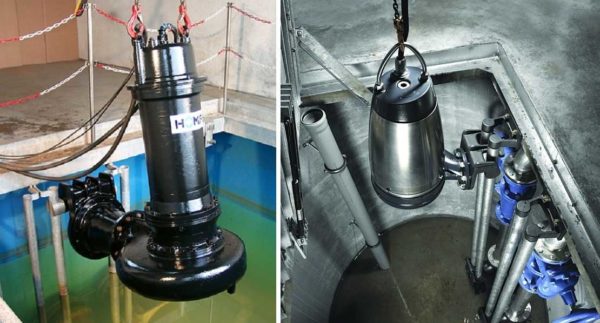
Installation options for submersible pumps for sewage (septic tank, drainage and storage wells)
The use of a corrugated hose can be avoided in models with a lower suction pipe. In this case, a rigid (plastic) pipe is mounted, its end being brought out so that the pump descending along the guides is mounted on it (in the photo on the right).
And the easiest installation option: just lower the device to the bottom on a chain. When the drains are pumped out to the desired level, the equipment is turned off and removed from the tank, rinsed, dried and carried to a utility room until next use.
| Name | Power | Lift height / head | Performance | Notes | Price |
|---|---|---|---|---|---|
| Grundfos SEG 40.12.2.1.502 | 1200 watts | 20.5 m | 18 m3 / h | Cable length 10 m, shredder | 1025$ |
| Ebara Right 75 M / A | 500 watts | 8.6 m | 14 m3 / h | Allowable solids diameter 35 mm | 250$ |
| Speroni SEM 150-VS | 1700 Wt | 11 m | 24 m3 / h | Float switch, chopper | 560$ |
| Homa Barracuda GRP 16 B D | 900 watts | 20 m | 18.7 m3 / h | Chopper | 1160$ |
| Ebara DW M 150 A | 1600 Wt | 16 m | 42 m3 / h | Permitted solids diameter 50 mm, float switch | 620$ |
| Speroni CUTTY 150 / N | 1500 watts | 17 m | 21 m3 / h | Chopper | 770$ |
| Irtysh PFS 50 / 125.120 | 1100 Wt | 6 m | 16 m3 / h | Float switch | |
| Irtysh PFS 50/125. 98 | 1100 Wt | 4 m | 7 m3 / h | Float switch | |
| Irtysh PF2 50 / 140.138 | 3000 watts | 22 m | 25 m3 / h | Float switch | |
| Dzhileks Fecalnik 150 / 7N 5302 | 550 watts | 7 m | 9 m3 / h | Permitted solids diameter 35 mm, float switch | 105$ |
| Dzhileks Fecalnik 200/10 F 5301 | 880 Wt | 10 m | 12 m3 / h | Permitted solids diameter 35 mm, float switch | 70$ |
| Dzhileks Fecalnik 255/11 N 5303 | 1100 Wt | 11 m | 15 m3 / h | Permitted solids diameter 35 mm, float switch | 125$ |
Despite the rather complex installation, it is submersible sewage pumps that are most popular. This is due to the fact that they are usually more powerful, and they can also pump media with particles up to 50 mm in size. And it is submersible models that can be with a grinder.
Advantages of submersible pumps:
- They can lift liquid from great depths.
- It can work in automatic mode, controlling the liquid level using a float.
- No need to worry about cooling.
- Low noise level.
It is submersible fecal pumps that can develop sufficient power to pump out contents from great depths. In the case of sewage, this may not be so important - the depth of septic tanks is not so great. But, if necessary, you can pump wastewater over a long distance over the surface. The main thing is that there are enough hoses.
You can read about sewage check valves and their installation here.
Semi-submersible fecal pump models
This type of equipment combines the advantages of surface and submersible pumps. Since the engine is above the surface of the water, there is no need to make it perfect waterproofing. Also, there is no need to tightly assemble all the parts in the body. All this has a positive effect on the price - it is much lower than for submersible models.
The disadvantage of fecal semi-submersible pumps is the smaller particle size that it can suck in, the shallower depths it can work at. The disadvantage is that a shredder cannot be installed on this type of pump. However, not all disadvantages are significant for domestic use. Too great depths for private use are not needed, and a simpler design makes repairs more affordable, so there are clearly more advantages.
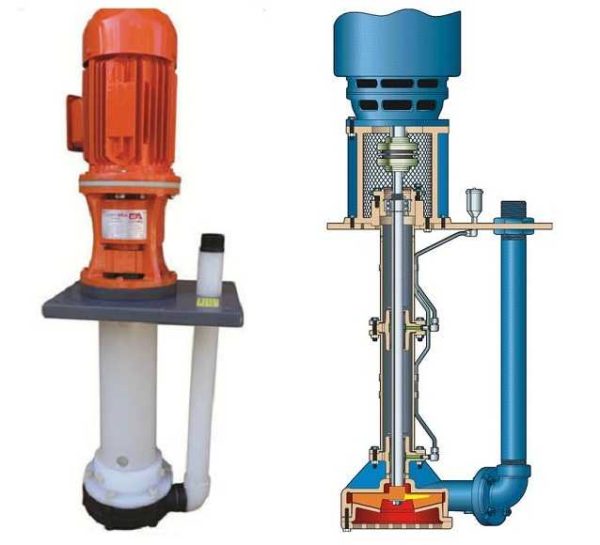
One of the types of semi-submersible devices - vertical
The peculiarity of the installation of semi-submersible pumps - it is necessary to install it so that the motor is above the water. The installation method depends on the model, it is spelled out in the instructions for the product. In general, there are several installation methods:
- A platform is made on the tank wall, equipment is fixed on it. With this method of installation, it is necessary to ensure that the liquid level does not rise above the platform - the upper part of the case is not tight. You can control the level using automation - sensors that give a signal to turn on and off.
- Installation on a floating cushion. This installation method is common for small semi-submersible fecal or drainage pumps for domestic use.
- Very small models, which are also called "barrel" models, can be hung on board.
Despite all the advantages, this model is not used very often. Basically, a fecal pump for sewage is acquired by a submersible or surface type.
| Name / manufacturer | Power | Rise / head | Feed / performance | Notes | Price |
|---|---|---|---|---|---|
| FGP 20/10 (L = 1.3 m) | 2.2 kW | 10 m | 20 m3 / hour | Maximum particle size 15 mm | 400$ |
| NCI-F100 | 0.5 kW | 8 m | 100 m3 / hour | Centrifugal with grinder | 1525$ |
| FGS50-12.5 | 4 kW | 12.5 m | 50 m3 / hour | Maximum particle size 15 mm | 760$ |
| FGS30-10 | 2.2 kW | 10 m | 30 m3 / hour | Maximum particle size 15 mm | 515$ |
Surface Models
The simplest installation is for surface type sewage pumps. The device itself is placed on the ground, and only the hoses are lowered into the container.
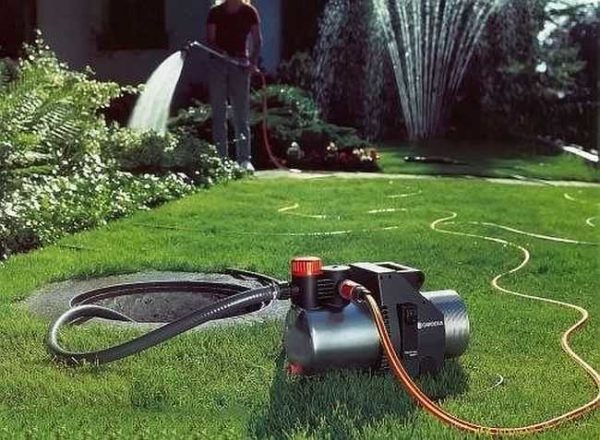
Surface models of faecal or drainage pumps are attractive for their mobility
The most serious drawback of such models is the phenomenon of cavitation, which occurs when pumping liquids from great depths. Cavitation is the saturation of the pumped medium with air bubbles. If such a mass gets into the pump working body, it will fail. That is why it is not recommended to use surface fecal pumps at depths greater than those for which they are intended. In the case of pumping out a septic tank or a storage well, the use of such models is justified. Their depth is shallow, and even not the most powerful motor will cope with the task. You just need to choose the right power of the unit.
| Name | A type | Power | Rise / head | Performance | Notes | Price |
|---|---|---|---|---|---|---|
| Caliber NBTs-380 | self-priming | 380 watts | 25 m | 28 l / min | No idle protection | 30-35$ |
| Whirlwind PN-370 | self-priming | 370 Wt | 30 m | 45 l / min | No idle protection | 38-42$ |
| Jilex Jumbo 60/35 N | self-priming | 600 watts | 35 m | 60 l / min | No idle protection, maximum particle size 0.8 mm | 104$ |
| Dzhileks Jumbo 70/50 P 3701 with an ejector | self-priming | 1100 Wt | 50 m | No idle protection, maximum particle size 0.8 mm | 115$ |
Please note that all surface pump models are designed for pumping water. Only a few of them can handle viscous liquids, and this should be indicated in the description or passport. The disadvantage of this equipment is that it requires a homogeneous medium - the maximum particle size that they are able to pump is 0.8 m. The price is undoubtedly attractive, but among the submersible models there are very inexpensive ones - for example, Jileks and Ebara (Ebara). The latter also have a stainless steel body and a wide range of models with different pressure and performance.
How to calculate the required lift height
When choosing a fecal pump for sewage, you need to pay attention to two characteristics: its power (performance) and lifting height. With productivity, everything is more or less clear - it depends on the volumes that need to be pumped. The height of the rise will have to be considered, because besides the vertical component, with which everything is clear (this is the depth of the well / septic tank, from which the drains must be raised), there is also a horizontal component - these drains must be transferred somewhere, usually to some kind of container. The distance to which the drains must be transferred in the horizontal plane is divided by 10. The result is added to the height of the rise from the well.
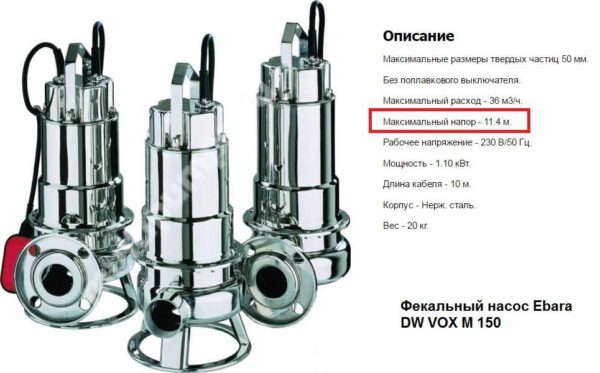
An example of the technical characteristics of a fecal pump for pumping out sewage
For example, the depth of the well is 4 meters, it is necessary to transfer the drains to 35 meters. Total we get: 4 m + 35 m / 10 = 7.5 m. The pump technical characteristics should have a lifting height of at least this figure, and preferably 20-25% more so that the equipment does not work at its limit, which leads to premature wear. ... Now you know how to calculate a fecal pump for sewage.

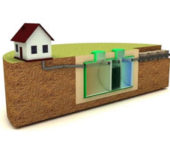
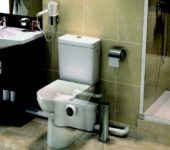
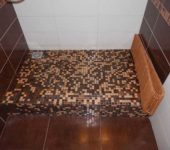
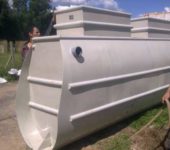
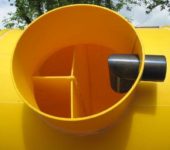





Good day! Your pump calculations for forced pumping out of the sewer are not entirely correct. My forced pumping system has a total length of 360 meters, with a reverse slope of 5 meters. A polyethylene pressure pipe with a diameter of 63 - 356 meters, a pressure damper well, and a gravity pipe 110 3 meters. The pump is single-phase, the outlet diameter is 50 mm, and the head is up to 20 meters. Rolls a container of 5 cubes in 30 - 40 minutes ...
I agree with you. The pump is 1.5 kW, the head is up to 27 m, the reverse slope is 2 m, it pumps at a distance of 1500 meters. So how to choose the right pump? If we count according to the method proposed by the author, the pump should give a head of 127 meters
Hello, please tell me the brand of your pump ...?
Hello! Please tell me, is it possible to leave the pump with the float plugged in at all times?
Will not burn unless the float breaks. For greater reliability, two floats are placed - one after the other. It's good that they are inexpensive. In this situation, the pump will definitely not burn out.
How to install two floats one after the other
Each float has two wires to shut off the pump. Let's call one float N1, the second N2. Connect in series. One wire of the float N1 to the circuit (phase), the second wire from N1 to the wire from N2, and the rest to the wire that goes to the pump (the phase will also go). Clear? or draw a diagram?
I need a pump for pumping out a thick clay mass, which brand should I choose? I liked the brand Ebara DW M 150 A 1600 W 16 m 42 m3 / h Allowable diameter of solids 50 mm, float switch $ 620, what are the discounts and how can I get it? My phone number is 8 778 657 94 85 I live in the city of Turkestan, South Kazakhstan region.
The site is informational. We don't sell anything. You have chosen a good model, but you have to look for sellers of it.
Hello! In connection with a hopeless situation, we are thinking of installing a pumping system all over the street, each pump for ourselves, about 12 farms, please tell me the power-to-head ratio of the pump required for pumping the sewage system over a distance of 250-300 meters, lifting height 1-1.5m, with a pipe with a diameter of 40mm ..., and the question is - how many farms, for example, could cooperate with one pipe 40-50-63 mm and pump from their pit into the pipe .... A system with one pump is excluded, everyone wants a pump at home ...
Hello! Our septic tank 3 wells. We will download from the third well. Please tell me how much distance should be between the pump and the bottom of the well?
I need a pump to pump out a sump. The dimensions of the pit are two by two meters. The height of the pit from the cover is 2.5 m. You need to pump it to a distance of 10 meters. Since only two people live at home (a private house), it flows into the pit mainly from washing, dishwasher, shower and toilet. Since the earth is a sandy part of the water itself leaves. We call the pumping out machine 5-6 times a year. Tell me which pump to choose.
I bought a cheap Vortex DN-900, i.e. with a power of 900 watts. I think that this power is not enough, and in general the pump looks flimsy as it is all made of plastic. I advise you to choose a power of 1 kW and in a metal case. Ideally, it is better to immediately take it with a chopper. Quite good reviews on the VORTEX FN-1100L and VORTEX FN-1500L pumps.
tell me the submersible fecal pump can work in continuous mode, that is, switching on and off every 3 minutes?
Maybe, but it will only quickly develop a resource. All of them are designed for a certain number of on / off switches, they also have a resource for operating time. In the permanent on / off mode, they will wear out quickly.
Hello!
Please tell me how to calculate how many kW the pump uses per month?
In our village, for some reason, a construction company connected a neighbor's pump to our house, now the question is - how much should a neighbor pay us for the pump's electricity?
Tell me which pump to buy for pumping sludge and feces from a cesspool with a volume of 4.5 m3 into the sewer at a distance of about 50 meters.
I have a Vortex DN-900 (900 W) - the distance from an outdoor toilet to a sewer pit is about 42 meters. I will clarify right away that they are pumped out only once a year. In your case, taking into account the greater distance, I would recommend taking a pump with a power of more than 1 kW. For example, you can look at JILEX Fecal 330/12 (1200 W) or see something in a stainless steel case.